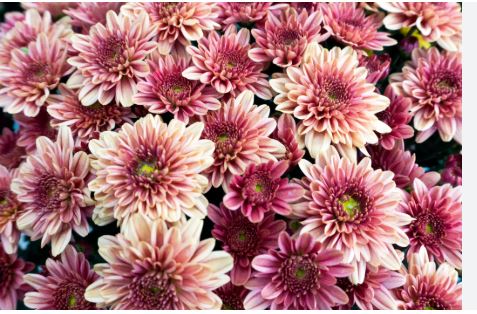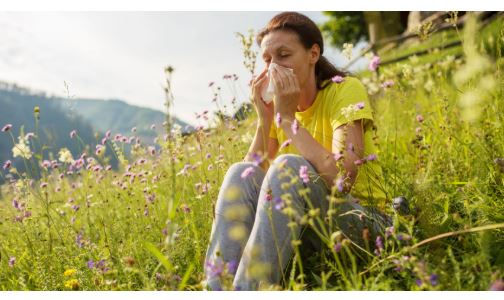
The worst flowers for people with allergies are those that produce large amounts of lightweight, wind-dispersed pollen, which easily becomes airborne and triggers symptoms like sneezing, itchy eyes, and respiratory discomfort. These plants are often pollinated by wind rather than insects or birds, leading to widespread pollen spread. Many belong to a specific plant family known for high pollen output, making them particularly problematic during their blooming seasons, typically late summer to fall. Avoiding these flowers is key for allergy sufferers aiming to enjoy a garden without health issues.
These flowers often thrive in various climates, including warm regions, and are popular for their vibrant colors and ecological benefits. However, their pollen can linger in the air, especially in dry or windy conditions, exacerbating hay fever or asthma. Some also have aromatic oils or sap that can cause skin irritation or contact dermatitis, adding to their allergenic potential. Gardeners should be cautious when handling these plants or planting them near living spaces.
To minimize allergy risks, avoid planting these flowers near windows, patios, or high-traffic areas where pollen can easily enter homes or affect daily activities. Choosing double-flowered or sterile hybrid varieties, which produce less pollen, can be a safer alternative. Maintaining garden hygiene by removing fallen blooms and using protective gear like gloves and masks during maintenance can also reduce exposure. Placing these plants in less windy garden areas can help limit pollen dispersal.
For allergy sufferers, creating a low-allergen garden involves selecting flowers with heavy, sticky pollen that relies on insect or bird pollination. In warm climates, where some of these problematic flowers thrive, opting for low-maintenance, low-pollen alternatives ensures a beautiful garden without health risks. Sharing your specific location can help tailor recommendations to avoid these allergenic plants and suit your local conditions, especially during peak pollen seasons. If you’d like, I can search for recent allergy-related gardening tips or trends to further assist.

Worst plants for allergy sufferers
Ragweed (Ambrosia spp.)
- Why It’s Bad for Allergies: Produces vast amounts of lightweight, wind-dispersed pollen, a leading cause of hay fever.
- Description: Green, inconspicuous flower spikes on weedy plants, often found in wild areas or disturbed soils.
- Garden Context: Rarely planted intentionally but invades gardens and roadsides.
- Allergy Impact: High pollen counts in late summer to fall trigger severe reactions.
Chamomile (Matricaria chamomilla)
- Why It’s Bad for Allergies: Part of the Asteraceae family, its pollen can cross-react with ragweed allergies.
- Description: Small, daisy-like white flowers with yellow centers, often grown for herbal tea.
- Garden Context: Used in herb gardens or as a low border plant.
- Allergy Impact: Pollen and plant oils can cause contact dermatitis or respiratory issues.
Sunflower (Helianthus annuus)
- Why It’s Bad for Allergies: Produces abundant pollen that, while heavy, can irritate when plants are brushed against.
- Description: Large, yellow, daisy-like flowerheads on tall stems, popular for their bold look.
- Garden Context: Grown in borders or as a focal point in sunny gardens.
- Allergy Impact: Pollen release in close proximity can trigger symptoms.
Daisy (Bellis perennis)
- Why It’s Bad for Allergies: Asteraceae family member with wind-dispersed pollen that can trigger hay fever.
- Description: White or pink petals around a yellow center, low-growing and lawn-friendly.
- Garden Context: Common in lawns, borders, or as ground cover.
- Allergy Impact: Pollen spreads easily, especially in breezy conditions.
Chrysanthemum (Chrysanthemum spp.)
- Why It’s Bad for Allergies: High pollen production in the Asteraceae family, often cross-reactive with ragweed.
- Description: Showy blooms in various colors like yellow, red, or white, blooming in fall.
- Garden Context: Popular for autumn displays in beds or containers.
- Allergy Impact: Pollen and plant oils can cause respiratory or skin irritation.
Goldenrod (Solidago spp.)
- Why It’s Bad for Allergies: Produces heavy pollen often mistaken for ragweed’s, causing confusion and some allergic reactions.
- Description: Bright yellow flower clusters on tall stems, native to many regions.
- Garden Context: Used in wildflower or meadow gardens for late-season color.
- Allergy Impact: Pollen can irritate, especially in high concentrations.
Aster (Symphyotrichum spp.)
- Why It’s Bad for Allergies: Asteraceae family, produces lightweight pollen that disperses easily.
- Description: Star-shaped flowers in purple, blue, or pink, blooming late summer to fall.
- Garden Context: Common in borders or native plant gardens.
- Allergy Impact: High pollen output aggravates seasonal allergies.
Yarrow (Achillea millefolium)
- Why It’s Bad for Allergies: Pollen from its tiny, clustered flowers can become airborne, especially in dry conditions.
- Description: Flat flowerheads in white, pink, or yellow with feathery foliage.
- Garden Context: Grown in borders or herb gardens for its drought tolerance.
- Allergy Impact: Can cause respiratory or skin irritation in sensitive individuals.
Cosmos (Cosmos bipinnatus)
- Why It’s Bad for Allergies: While insect-pollinated, its pollen can become airborne when disturbed.
- Description: Airy, daisy-like flowers in pink, white, or purple on slender stems.
- Garden Context: Popular in cottage or wildflower gardens.
- Allergy Impact: Moderate pollen spread can trigger mild symptoms.
Zinnia (Zinnia elegans)
- Why It’s Bad for Allergies: Produces pollen that, while heavy, can irritate when plants are handled or in close proximity.
- Description: Bright, daisy-like blooms in various colors, blooming summer to frost.
- Garden Context: Used in borders, beds, or cutting gardens.
- Allergy Impact: Pollen exposure during gardening can cause discomfort.
Black-Eyed Susan (Rudbeckia hirta)
- Why It’s Bad for Allergies: Asteraceae family, produces pollen that can be bothersome in large plantings.
- Description: Yellow petals with dark centers, native and drought-tolerant.
- Garden Context: Common in wildflower or prairie-style gardens.
- Allergy Impact: Pollen can trigger reactions, especially in late summer.
Coneflower (Echinacea spp.)
- Why It’s Bad for Allergies: Asteraceae family, moderate pollen production that can irritate when airborne.
- Description: Pink, purple, or white daisy-like flowers with raised centers.
- Garden Context: Grown in perennial beds for long-lasting blooms.
- Allergy Impact: Pollen may worsen symptoms for ragweed-sensitive individuals.
Dahlia (Dahlia spp.)
- Why It’s Bad for Allergies: Single-flowered varieties produce more pollen, which can become airborne when disturbed.
- Description: Showy blooms in various shapes and colors, from red to white.
- Garden Context: Popular in borders or as statement plants.
- Allergy Impact: Pollen and plant sap can cause respiratory or skin reactions.
Baby’s Breath (Gypsophila paniculata)
- Why It’s Bad for Allergies: Tiny flowers produce lightweight pollen that can disperse in wind.
- Description: Delicate, cloud-like clusters of white or pink flowers.
- Garden Context: Used in borders or as filler in floral arrangements.
- Allergy Impact: Pollen can trigger sneezing or eye irritation in close quarters.
Amaranth (Amaranthus spp.)
- Why It’s Bad for Allergies: Produces large quantities of lightweight, wind-dispersed pollen.
- Description: Feathery flowerheads in red, purple, or green, often grown for ornamental or edible purposes.
- Garden Context: Used in borders or as a bold accent in sunny gardens.
- Allergy Impact: High pollen output in summer can trigger severe hay fever symptoms.
Blanket Flower (Gaillardia spp.)
- Why It’s Bad for Allergies: Asteraceae family member with pollen that can become airborne when disturbed.
- Description: Daisy-like flowers in red, yellow, or orange with vibrant patterns.
- Garden Context: Popular in drought-tolerant or native plant gardens.
- Allergy Impact: Pollen can irritate, especially in large plantings or dry conditions.
Coreopsis (Coreopsis spp.)
- Why It’s Bad for Allergies: Produces moderate pollen in the Asteraceae family, which can cross-react with ragweed allergies.
- Description: Bright yellow or pink daisy-like flowers, blooming summer to fall.
- Garden Context: Common in borders or wildflower gardens for long-lasting color.
- Allergy Impact: Pollen dispersal can cause sneezing or eye irritation.
Marigold (Tagetes spp.)
- Why It’s Bad for Allergies: Asteraceae family, produces pollen and has sap that can cause contact dermatitis.
- Description: Bright orange, yellow, or red pom-pom-like flowers with a strong scent.
- Garden Context: Grown in beds or containers, often to repel pests.
- Allergy Impact: Pollen and handling the plant can trigger respiratory or skin reactions.
Cornflower (Centaurea cyanus)
- Why It’s Bad for Allergies: Asteraceae family, produces lightweight pollen that can disperse in wind.
- Description: Blue, pink, or white thistle-like flowers, popular in wildflower mixes.
- Garden Context: Used in meadows or cottage gardens for a natural look.
- Allergy Impact: Pollen can exacerbate seasonal allergies, especially in open areas.
Tansy (Tanacetum vulgare)
- Why It’s Bad for Allergies: Asteraceae family with high pollen production and irritant sap.
- Description: Clusters of small, yellow, button-like flowers on tall stems.
- Garden Context: Grown in herb gardens or as a border plant for its ferny foliage.
- Allergy Impact: Pollen and plant oils can cause respiratory or skin irritation.
Sneezeweed (Helenium autumnale)
- Why It’s Bad for Allergies: Asteraceae family, produces pollen that can trigger reactions despite its name being unrelated to sneezing.
- Description: Yellow, orange, or red daisy-like flowers with raised centers, blooming late summer.
- Garden Context: Used in perennial beds or native gardens.
- Allergy Impact: Pollen can worsen symptoms for ragweed-sensitive individuals.
Liatris (Liatris spicata)
- Why It’s Bad for Allergies: Asteraceae family, moderate pollen production that can become airborne.
- Description: Tall spikes of purple or white feathery flowers, blooming summer.
- Garden Context: Popular in prairie or native gardens for vertical interest.
- Allergy Impact: Pollen can irritate, especially in breezy conditions.
Feverfew (Tanacetum parthenium)
- Why It’s Bad for Allergies: Asteraceae family with pollen and aromatic oils that can cause dermatitis or respiratory issues.
- Description: Small, white, daisy-like flowers with yellow centers, often grown for medicinal use.
- Garden Context: Used in herb or cottage gardens.
- Allergy Impact: Pollen and plant contact can trigger allergic reactions.
Joe-Pye Weed (Eutrochium purpureum)
- Why It’s Bad for Allergies: Produces pollen that, while insect-pollinated, can become airborne in large plantings.
- Description: Large, mauve-pink flowerheads on tall stems, blooming late summer.
- Garden Context: Common in meadow or wetland gardens.
- Allergy Impact: Pollen can cause mild to moderate respiratory symptoms.
Mexican Hat (Ratibida columnifera)
- Why It’s Bad for Allergies: Asteraceae family with pollen that can disperse when disturbed.
- Description: Cone-shaped flowerheads with drooping yellow or red petals, resembling a sombrero.
- Garden Context: Used in native or drought-tolerant gardens.
- Allergy Impact: Pollen can irritate, particularly in dry, windy conditions.
Shasta Daisy (Leucanthemum × superbum)
- Why It’s Bad for Allergies: Asteraceae family, produces pollen that can trigger hay fever.
- Description: Classic white petals with yellow centers, blooming summer.
- Garden Context: Popular in borders or cottage gardens for its clean look.
- Allergy Impact: Pollen spreads easily, causing discomfort for sensitive individuals.
Tithonia (Tithonia rotundifolia)
- Why It’s Bad for Allergies: Asteraceae family, produces pollen that can become airborne when handled.
- Description: Bright orange or red daisy-like flowers on tall stems, known as Mexican sunflower.
- Garden Context: Grown in sunny borders or wildflower gardens.
- Allergy Impact: Pollen exposure during gardening can trigger symptoms.
Oxeye Daisy (Leucanthemum vulgare)
- Why It’s Bad for Allergies: Asteraceae family with lightweight, wind-dispersed pollen.
- Description: White, daisy-like flowers with yellow centers, often found in wild settings.
- Garden Context: Used in meadows or as a naturalized ground cover.
- Allergy Impact: High pollen output can cause significant respiratory issues.
Tips for Managing Allergenic Flowers
- Avoid Planting Near Living Spaces: Place these flowers away from windows, patios, or high-traffic areas to limit pollen exposure.
- Use Protective Gear: Wear masks and gloves when handling these plants to reduce contact with pollen or irritant sap.
- Opt for Low-Allergen Alternatives: Choose double-flowered or sterile hybrids that produce less pollen, like double dahlias.
- Regional Considerations: In warm climates, plants like tithonia and marigolds thrive but may pose higher risks during dry seasons. Share your specific location for tailored advice.